The minute I get into my Stockholm hotel room I throw off my shoes and pull off my socks. I let my feet touch the hardwood floor, which surprises me. Hotel rooms usually have this desperate modern carpeting, but here, it is cool, tan hardwood floors. I go over to the mini bar and grab a water bottle (best way to beat the jet lag is water, right?). I squeeze the bottle tight in my hands. It is glass like a mini milk bottle from the 1950s. Water has never felt so heavy—the glass thick, and clear. A card next to the water bottle tells me glass is better than plastic for the environment. I believe it and finish the bottle. I walk over to the window, which looks out over Old Town (Galma Stan). From this height I can see all the islands that make up the city of Stockholm. I think: I can exist on consuming this view alone.
But, after a couple minutes of gazing, I realize I need food as soon as humanly possible.
I walk 15 minutes from my hotel in Östermalm,—a northern upscale neighborhood in Stockholm— to Barrels-Burgers and Beer in Old Town (Galma Stan). It is Friday afternoon and it’s packed. Oddly enough, burgers are pretty popular in Stockholm. I get a table at the bar and order a burger and beer (this is one of the only places that beer is served in a stein. In most other restaurants it is served in a white wine glass). I drink my beer and devour my burger.
Now comes the hard part: how much to tip? Back home in New York, I tip a solid 20%, but in foreign countries I never know what’s appropriate. I strike up a conversation with the bartender. We talk about beer and how it is the drink of choice for most people. I tell him it is interesting that there are no gendered stereotypes when it comes to a Swedes drink order. My new bartender friend tells me: beer is the best, and everyone should always drink the best. I tell him that I am from the States and we usually tip for every meal. He smiles and says that isn’t the case in Sweden. Everyone working there makes a living wage and it is okay to tip 5-10% if I want, but no tip or rounding up is also completely acceptable. I leave a tip anyway and start my walk back towards my hotel.
I think how interesting it was to hear the bartender speak about his job. He never once said that he was “just” a bartender or that this was his “day job.” He seemed happy. He seemed like he enjoyed his job and his coworkers. Meanwhile in the States we feel the need to justify why we aren’t President or CEO. Here you can just be whoever you are that day and that’s okay.
I quickly learn that food is a big, yet expensive, part of Stockholm’s culture. It is home to many Michelin-star restaurants and “cheap eats” are considered meals under $30. Every meal is delicious and I get to meet amazing local people, like the bartender, who teaches me so much about life in Sweden. I go to three amazing eats: La Neta, Falafelbaren, and Meatballs for the People. All three would be great for a quick lunch, jammed packed with locals, eating high quality food. They’re also all conveniently located in Södermalm, an area frequently compared to Brooklyn by locals. I love walking around that area and shopping at places like Grandpa followed with the lunch special at La Neta: two grande tacos, rice, and a beer.

I go to four casual, but slightly more upscale restaurants: Oaxen Slip, Speceriet, PA and Co, and B.A.R. The first two are back-pocket restaurants, which is a term for when a famous chef has a more casual restaurant in which they test new dishes for their Michelin restaurant.
One of my favorite meals, though, is at a bar called The Burgundy. The bartender pours me a beer and we start talking. He speaks perfect English, as do most people in Stockholm (everybody learns English from third grade all the way through university…and all schooling is free, by the way.) Sebastian, the bartender, tells me he feels just as natural speaking English as he does Swedish. We talk about the upcoming presidential election in the States. To my surprise, he knows everything about the race. He wants Bernie Sanders to win, even though to the Swedes, Sanders is still very far right. Sebastian tells me he has been to Brooklyn and that he wants to move there when he finishes his degree. I look puzzled: why leave Stockholm? He tells me: the American dream. Even though that concept isn’t really attainable anymore, he says, it is still a possibility. In America if you are one in a million, that means you’re something around the world. In Sweden, if you are one in a million you might be something in Europe, but you still won’t have America. You have to be in America to make it in America.
This is one of the best conversations I’ve had with anyone, let alone a stranger speaking a second language. Sebastian, like most people I find in Stockholm is curious, intelligent, friendly, and yet still humble. These are the people that make my trip memorable, engaging, and quite frankly pretty easy.
Every day of my trip I have an amazing meal and meet wonderful people. Something else I did every day is fika, a term that everyone knows in Stockholm. Fika is a coffee break, in which you buy a cup of java along with a special Swedish cinnamon bun. You relax, eat, drink. Swedish employers actually have to give employees two 15-minute fika breaks, each day. I take this law very seriously: for my fika I go to Coffice, and for my second, Drop Coffee. I end up going every day.
Both are in Södermalm and serve great single-origin coffee and local pastries. Coffice is a “working” coffee shop, so it has internet, copiers, printers, and a quiet room to work in the back. I order their yogurt parfait and an Americano for breakfast, and later, a cinnamon roll with another coffee. Due to the generous maternity/paternity leave in Sweden (18 months at 80% pay per child), I see a lot of “latte moms and dads”. They are called this because they usually sip their latte while pushing their kids in a stroller. I have never seen so many parents and children together, wandering around on a weekday afternoon. Even the busses have stroller parking.
Although my trip to Stockholm might be over-saturated with food, there are many other things to do besides eat. The Vasa Museum, the Fotografiska Museum, the Modern Art Museum, and the tour of City Hall are all wonderful. The Fotografiska Museum and the Modern Art Museum actually have amazing cafes, at which I happily take my fika. I am most impressed by the Fotografiska Museum. It is showing a Bettina Rheims exhibit that focuses on women and trans women. This and other exhibits (past and current) emphasize minorities in a significant way. I respect the fact that they choose to highlight these groups, when in the States we might be scared of the ramifications of a show of this kind. I see moms walking around with their kids, exposing them to various cultures without batting an eye. I also notice that every bathroom in the Modern Art Museum (and in other places around Stockholm) is non-gendered. There are men and women— and everyone in between— sharing a 10-stall bathroom without a second thought.
One day it is 90 degrees, so I take the ferry to Fjäderholmarna, an island 20 minutes away. This is one of the most serene places I’ve visited. It is a small island (I walk the whole way around it twice in 30 minutes) surrounded by beaches, with a forest in the middle. There are around 10 different restaurants to choose from on the island, along with a couple of cafes. There are also a handful of cute artist shops: glass, pottery, and welding.
On the day that I leave, I wake up at 4am to get to the airport. The sun has already risen (Swedes only get a couple hours of darkness in the summer—because of this restaurants are open until midnight). I look back out the window at the bridge to Galma Stan. The water is still and the sky is turning a lighter shade of blue. I don’t want to leave. I have learned so much from the people and so much about the history and culture of Stockholm. In my head, I am already counting the days until I can return, and have my next fika.
________________________________________________________________________________________
Laura Buccieri is a poet and writer from the Bay Area. Her work has appeared most recently in Prelude, Potluck, Word Riot, and FORTH. She lives in the East Village and is currently an MFA candidate in Creative Writing at the New School.

 Save up to 60% on Business Class. Call 1-800-435-8776
Save up to 60% on Business Class. Call 1-800-435-8776
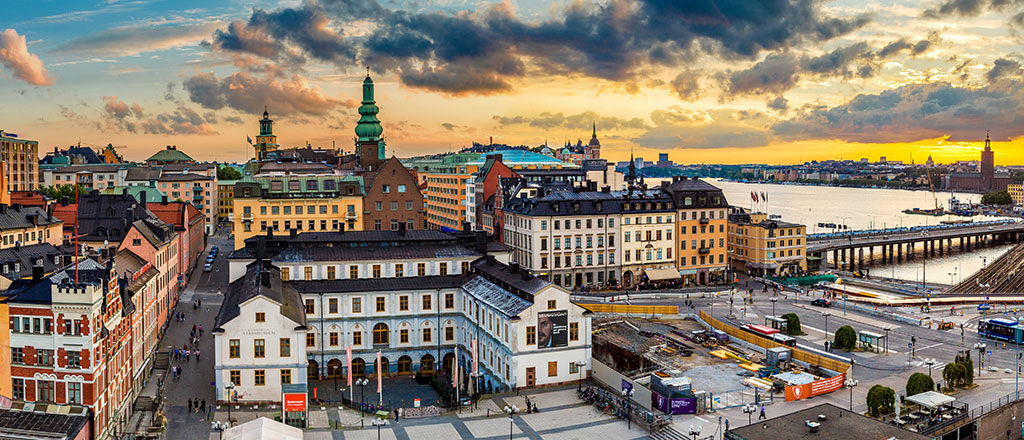
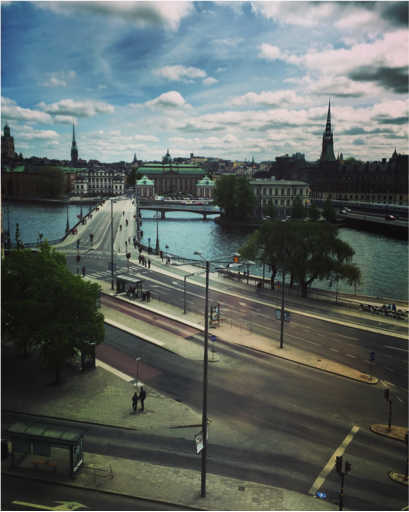






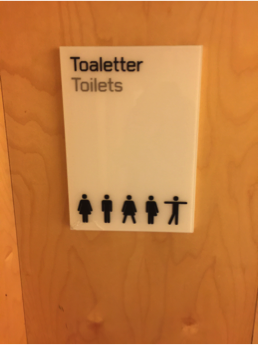
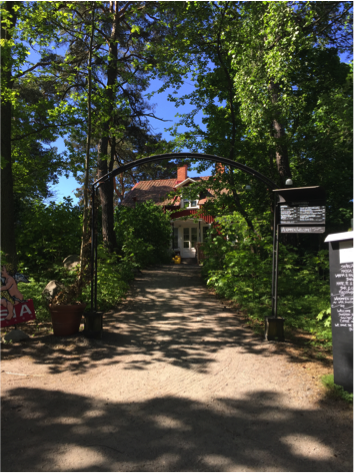
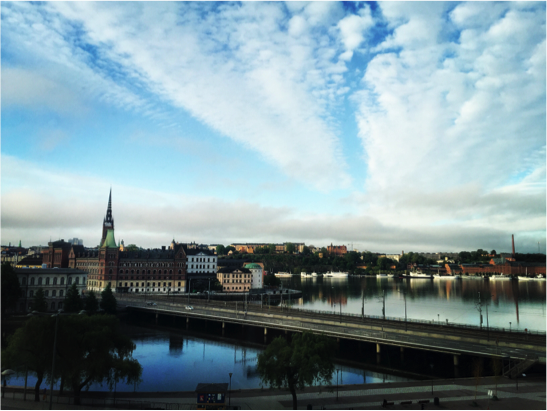
Fantastic story…looking forward to visiting one day and enjoying A burger, beer and fika break!
Fine way of explaining, and pleasant piece of writing to
get facts regarding my presentation subject matter, which i am going to deliver in institution of higher education.